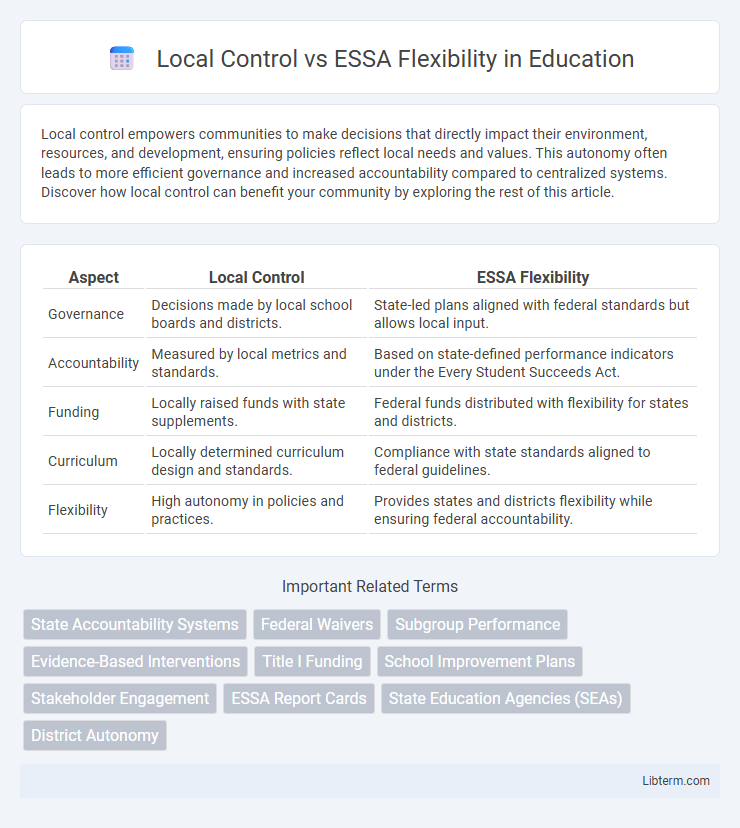Local control empowers communities to make decisions that directly impact their environment, resources, and development, ensuring policies reflect local needs and values. This autonomy often leads to more efficient governance and increased accountability compared to centralized systems. Discover how local control can benefit your community by exploring the rest of this article.
Table of Comparison
| Aspect | Local Control | ESSA Flexibility |
|---|---|---|
| Governance | Decisions made by local school boards and districts. | State-led plans aligned with federal standards but allows local input. |
| Accountability | Measured by local metrics and standards. | Based on state-defined performance indicators under the Every Student Succeeds Act. |
| Funding | Locally raised funds with state supplements. | Federal funds distributed with flexibility for states and districts. |
| Curriculum | Locally determined curriculum design and standards. | Compliance with state standards aligned to federal guidelines. |
| Flexibility | High autonomy in policies and practices. | Provides states and districts flexibility while ensuring federal accountability. |
Understanding Local Control in Education
Local control in education emphasizes empowering school districts and educators to make decisions tailored to their community's unique needs, priorities, and student demographics. This approach allows flexibility in curriculum design, resource allocation, and instructional methods, fostering innovation and responsiveness to local challenges. Understanding local control is essential for realizing educational equity and effectiveness within the framework of ESSA flexibility provisions.
Overview of the Every Student Succeeds Act (ESSA)
The Every Student Succeeds Act (ESSA) empowers states with increased local control over education standards, accountability measures, and intervention strategies compared to its predecessor, the No Child Left Behind Act. States design their own accountability systems and tailor support for underperforming schools while adhering to federal requirements for equity and transparency. ESSA emphasizes a balance between federal oversight and state autonomy to improve student outcomes effectively.
Key Principles of ESSA Flexibility
ESSA flexibility emphasizes state and local control by allowing states to design tailored accountability systems that reflect unique educational contexts while adhering to federal requirements. Key principles include empowering states to set ambitious yet achievable goals, supporting continuous improvement for all student subgroups, and promoting evidence-based interventions to address achievement gaps. This framework ensures that local educators have the autonomy to implement strategies that best meet their students' needs within a consistent national accountability structure.
Historical Context: Local vs Federal Governance
The debate between local control and ESSA flexibility originates from longstanding tensions between local educational autonomy and federal oversight established since the Elementary and Secondary Education Act of 1965. Historically, states and school districts have maintained primary authority over curriculum and funding decisions, while federal policies imposed mandates aimed at equity and accountability. ESSA rebalanced this dynamic by granting states greater discretion in setting standards and accountability systems while ensuring protections for historically underserved students.
Impact of ESSA on District-Level Autonomy
The Every Student Succeeds Act (ESSA) enhances district-level autonomy by shifting significant decision-making powers from the federal government to local school districts, allowing tailored educational approaches that reflect community needs. ESSA requires districts to develop their own accountability systems, focusing on multiple measures of student success beyond standardized test scores, which strengthens localized control over educational outcomes. This increased flexibility empowers districts to allocate resources more strategically, implement targeted interventions, and innovate curricula to improve student achievement within their unique contexts.
State Decision-Making Under ESSA
State decision-making under the Every Student Succeeds Act (ESSA) grants enhanced local control by allowing states to design accountability systems tailored to their unique educational contexts. This flexibility enables states to set academic standards, determine interventions, and allocate resources in alignment with state priorities rather than federal mandates. ESSA's framework supports innovative policies that reflect diverse student needs while maintaining federal oversight to ensure equity and academic progress.
Balancing Accountability and Local Freedom
Balancing accountability and local freedom under ESSA requires states to design accountability systems that meet federal standards while allowing districts to tailor strategies to their unique needs. ESSA's flexibility supports innovative local interventions and resource allocation, fostering education approaches aligned with community priorities. Effective local control ensures stakeholder engagement and responsiveness, enhancing educational outcomes without compromising transparency and performance benchmarks.
Challenges Faced by Local Districts with ESSA Flexibility
Local districts often struggle with balancing autonomy and compliance under ESSA flexibility, as they must tailor educational strategies while meeting federal accountability standards. Limited funding and inconsistent guidance complicate efforts to effectively implement tailored interventions and innovations. Navigating these challenges requires districts to enhance data management systems and foster collaboration among stakeholders to improve student outcomes.
Success Stories: Local Innovation Enabled by ESSA
ESSA flexibility has empowered numerous school districts to implement local control, resulting in tailored educational strategies that address specific student needs and improve outcomes. For example, districts in Massachusetts leveraged ESSA provisions to expand early literacy programs, significantly raising reading proficiency rates among elementary students. These success stories highlight how local innovation, supported by federal flexibility, drives effective education reforms rooted in community priorities.
Future Directions for Local Control in Federal Policy
Future directions for local control in federal policy emphasize increased autonomy for school districts to tailor educational programs to community needs while ensuring accountability through data-driven outcomes. ESSA flexibility provisions grant states and districts the option to design innovative accountability systems, promoting locally relevant strategies to improve student achievement. Continued federal support is expected to balance autonomy with equity, enabling targeted resource allocation and personalized learning models within the framework of national education goals.
Local Control Infographic

 libterm.com
libterm.com